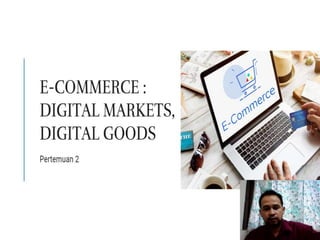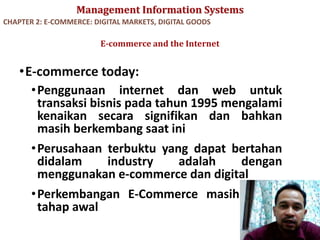Pertemuan 3 - E Commerce.ppt
- 1. E-COMMERCE : DIGITAL MARKETS, DIGITAL GOODS Chapter 2
- 2. Management Information Systems Menurut Laudon dan Laudon dalam Nursani, et al. (2019), e-commerce merupakan suatu keadaan dimana proses jual beli produk dilakukan secara elektronik oleh konsumen serta dari perusahaan ke perusahaan dengan menggunakan computer sebagai perantara dalam transaksi bisnis. ┬® Prentice Hall 2011 2
- 3. Management Information Systems Dengan adanya e- commerce memungkinkan sebuah perusahaan atau pemilih usaha untuk dapat menjual produk yang mereka buat kepada konsumer yang lebih banyak. Seolah-olah batas antar negara semakin hilang. Dengan kata lain, perusahaan dapat mencakup pasar yang lebih luas. Keuntungan E-Commerce
- 4. Management Information Systems ŌĆóE-commerce today: ŌĆóPenggunaan internet dan web untuk transaksi bisnis pada tahun 1995 mengalami kenaikan secara signifikan dan bahkan masih berkembang saat ini ŌĆóPerusahaan terbuktu yang dapat bertahan didalam industry adalah dengan menggunakan e-commerce dan digital ŌĆóPerkembangan E-Commerce masih dalam tahap awal E-commerce and the Internet CHAPTER 2: E-COMMERCE: DIGITAL MARKETS, DIGITAL GOODS ┬® Prentice Hall 2011 4
- 5. Management Information Systems E-commerce and the Internet THE GROWTH OF E-COMMERCE Retail e-commerce revenues grew 15ŌĆō25 percent per year until the recession of 2008ŌĆō2009, when they slowed measurably. In 2010, e-commerce revenues are growing again at an estimated 12 percent annually. FIGURE 10-1 CHAPTER 2: E-COMMERCE: DIGITAL MARKETS, DIGITAL GOODS ┬® Prentice Hall 2011 5
- 6. Management Information Systems E-commerce and the Internet THE BENEFITS OF DISINTERMEDIATION TO THE CONSUMER The typical distribution channel has several intermediary layers, each of which adds to the final cost of a product, such as a sweater. Removing layers lowers the final cost to the consumer. FIGURE 10-2 CHAPTER 2: E-COMMERCE: DIGITAL MARKETS, DIGITAL GOODS ┬® Prentice Hall 2011 6
- 7. Management Information Systems ŌĆóTypes of e-commerce ŌĆóBusiness-to-consumer (B2C) ŌĆóBusiness-to-business (B2B) ŌĆóConsumer-to-consumer (C2C) ŌĆóMobile commerce (m-commerce) E-commerce: Business and Technology CHAPTER 2: E-COMMERCE: DIGITAL MARKETS, DIGITAL GOODS ┬® Prentice Hall 2011 7
- 8. Management Information Systems ŌĆóE-commerce revenue models 1. Advertising 2. Sales 3. Subscription 4. Free 5. Transaction Fee 6. Affiliate E-commerce: Business and Technology CHAPTER 2: E-COMMERCE: DIGITAL MARKETS, DIGITAL GOODS ┬® Prentice Hall 2011 8
- 9. Management Information Systems ┬® Prentice Hall 2011 9
- 10. Management Information Systems ŌĆóE-commerce marketing ŌĆó Internet memberi pemasar cara baru untuk mengidentifikasi dan berkomunikasi dengan pelanggan ŌĆó Pemasaran ekor panjang: Kemampuan untuk menjangkau khalayak luas dengan biaya murah ŌĆó Penargetan perilaku: Melacak perilaku online individu di ribuan situs Web ŌĆó Format iklan termasuk pemasaran mesin pencari, iklan bergambar, multimedia, dan email ŌĆó Copywriting E-commerce: Business and Technology CHAPTER 2: E-COMMERCE: DIGITAL MARKETS, DIGITAL GOODS ┬® Prentice Hall 2011 10 Pemasaran ekor panjang: Kemampuan untuk menjangkau khalayak luas den
- 11. Management Information Systems ŌĆó Business-to-business e-commerce ŌĆó Electronic data interchange (EDI) ŌĆó Pertukaran transaksi standar komputer-ke-komputer seperti faktur, pesanan pembelian ŌĆó Industri besar memiliki standar EDI yang menentukan bidang struktur dan informasi dokumen elektronik untuk industri tersebut ŌĆó Semakin banyak perusahaan yang beralih dari jaringan pribadi ke Internet untuk terhubung ke perusahaan lain E.g. Procurement: Bisnis sekarang dapat menggunakan Internet untuk menemukan sebagian besar pemasok berbiaya rendah, mencari katalog online produk pemasok, bernegosiasi dengan pemasok, melakukan pemesanan, dll. E-commerce: Business and Technology CHAPTER 2: E-COMMERCE: DIGITAL MARKETS, DIGITAL GOODS ┬® Prentice Hall 2011 11
- 12. Management Information Systems E-commerce: Business and Technology ELECTRONIC DATA INTERCHANGE (EDI) Companies use EDI to automate transactions for B2B e-commerce and continuous inventory replenishment. Suppliers can automatically send data about shipments to purchasing firms. The purchasing firms can use EDI to provide production and inventory requirements and payment data to suppliers. FIGURE 10-6 CHAPTER 2: E-COMMERCE: DIGITAL MARKETS, DIGITAL GOODS ┬® Prentice Hall 2011 12
- 14. DATA INTERNET INDONESIA 2022 Pengguna Internet 73,7%dari total penduduk Indonesia Pengguna Media Sosial 68,9%dari total penduduk Indonesia Waktu rata-rata penggunaan internet per hari 8 J am 36 Menit Waktu rata-rata Sosial Media per hari 3 jam 1 7 menit WaktumenontonIklanper Iklan 25.5 Menit
- 15. PENGGUNAAN SOSIAL MEDIA DI INDONESIA
- 16. Facebook Usia rata-rata pengguna ialah 25-34 tahun, sedangkan 49% pengguna harian berada dalam kelompok usia 25-49 tahun 43,6% pengguna adalah perempuan, 56,4% pengguna adalah laki- laki Lebih menyukai tipe konten berbentuk video (rata-rata engagement rate 8,29%) Paling aktif pada Senin, Jumat, Sabtu, dan Minggu Instagram 70% pengguna Instagram berusia di bawah 35 tahun, dengan usia dominan 25-34 tahun, diikuti oleh kelompok usia 18-24 tahun 51,4% pengguna Instagram adalah perempuan 90% pengguna mengikuti akun- akun brand atau brand-related content Pengguna aktif pada hari Senin dan Kamis Youtube Usia rata-rata pengguna YouTube adalah 15-35 tahun, dengan mayoritas penggunanya adalah dewasa dan millenial. Sebagian besar (56%) pengguna YouTube adalah laki-laki 684.000 jam video ditonton setiap menitnya, artinya audiens lebih suka menyaksikan konten berbentuk video Audiens lebih suka mengakses YouTube pada hari Sabtu dan Minggu TikTok Sebagian besar audiensnya berusia 10- 19 tahun (32,5%) dan 20- 29 tahun (29,5%) 60% penggunanya adalah perempuan Audiens-nya aktif setiap hari Waktu terbaik untuk mengunggah konten adalah sore hari setelah jam pulang sekolah atau saat libur sekolah MEDIA SOSIAL
- 20. Management Information Systems Keyword tool Long tail Keyword Short tail Keyword Backlink
- 22. Strategi Online Marketing Packaging Bungkuslah barang ŌĆō barang yang anda jual semenarik mungkin. Jangan engga untuk memberikan kartu ucapan terima kasih atau bonus !! LetŌĆÖs Start your business Segera lakukan dan praktikkan hari ini, jangan pernah tunda karena waktu yang sudah lewat tidak dapat kembali Tentukan Platform Anda juga perlu mengenal berbagai kelebihan dan kekurangan masing- masing platform sehingga bisa memanfaatkannya secara optimal. Foto Yang Menarik Segera siapkan foto produk anda yang terbaik dan jikalau perlu sewalah fotografer profesional untuk memastikan produk yang anda jual diminati Copy Writing Buatlah kata ŌĆō kata yang menarik untuk menarik konsumen/pembeli anda. Ingat gambar dan kata ŌĆō kata adalah poin utama dalam melakukan penjualan. Rutin !! Dalam melakukan apapun rutinkanlah dalam melakukan sesuatu secara konsisten. Buat konten yang berguna sesekali walaupun itu tidak mengenai produk anda.,
- 23. 23
Editor's Notes
- #5: This slide discusses what e-commerce is, and what the state of e-commerce is today. The text states that e-commerce history mirrors those of other technology innovations. What other innovations is e-commerce similar to? Students probably will not know about the early days of radio and TV, but perhaps they will remember cassette music, VHS video tapes, and even CDs which though still with us are definitely declining in sales. There are many current trends in e-commerce, from e-books to mobile purchasing. Ask the students to work with you to list some of these new trends in e-commerce.
- #6: This graphic illustrates the continuing growth of e-commerce. From the text: ŌĆ£E-commerce grew at double-digit rates until the recession of 2008ŌĆō2009 when growth slowed to a crawl. In 2009, e-commerce revenues were flat, not bad considering that traditional retail sales were shrinking by 5 percent annually. In fact, e-commerce during the recession was the only stable segment in retail. Despite the recession, in 2010, the number of online buyers increased by 6 percent to 133 million, and the average annual purchase is up 5 percent to $1,139. AmazonŌĆÖs sales grew by 28 percent in the year.
- #7: This graphic illustrates how disintermediation reduces prices to consumers. It also allows manufacturers to earn more profit for the product by eliminating the middle man. Are middle men really necessary? You should ask students who they think is a ŌĆ£middle man.ŌĆØ Walmart is, for instance, a distributor and retailer. Do they provide an important function? Why canŌĆÖt manufacturers just ignore Walmart and sell directly to the customer? Even though market disintermediation sounds like a good thing because costs and prices go down, for the most part manufacturers kept their distribution partners and channels. Walmart is still needed by manufacturers like P&G to sell soap.
- #8: This slide introduces the types of e-commerce. B2C, B2B, and C2C e-commerce are categorized according to the nature of the participants. M-commerce is a category based on the nature of the connection to the Internet. Ask students to provide examples of the different types of e-commerce listed here. Most students will find it hard to come up with a B2B example. One place you can visit on the Web is grainger.com, one of the largest B2B marketplaces in the U.S. Another is mcmaster.com, and also elemica.com (chemical industry).
- #9: This slide discusses the ways in which e-commerce sites make money ŌĆō their revenue model. Ask students to give examples of sites for each type of revenue model. Advertising ŌĆō Yahoo Sales ŌĆō Amazon Subscription ŌĆō Wall Street Journal Free/freemium ŌĆō Flckrs Transaction fee ŌĆō eTrade Affiliate ŌĆō Amazon, MyPoints
- #11: Ask students to explain why marketers are looking to analyze blog content, and content from chat rooms and message boards. Have students describe and evaluate their experiences with advertising on social networks, via e-mail, and other online formats.
- #12: This slide looks at changes brought to B2B e-commerce by Internet technologies. Note that the Internet and Web technology enable businesses to create new electronic storefronts for selling to other businesses with multimedia graphic displays and interactive features similar to those for B2C commerce. Alternatively, businesses can use Internet technology to create extranets or electronic marketplaces for linking to other businesses for purchase and sale transactions.
- #13: This graphic illustrates how EDI is used by firms and their suppliers to automate transactions for both B2B e-commerce and continuous replenishment. EDI is still widely used but it has limitations outlined in the book and is not designed for supporting marketplace operations where you have hundreds of vendors and buyers.






















